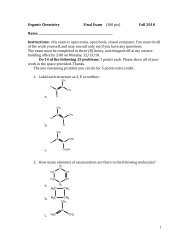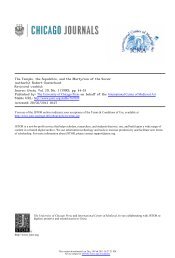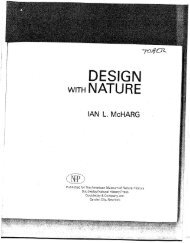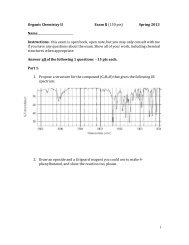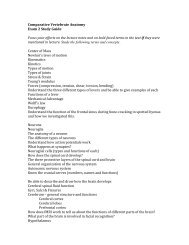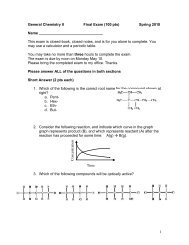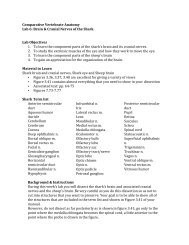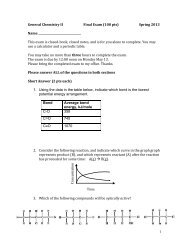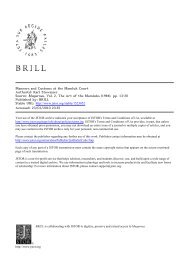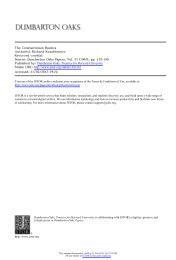The Sound of a Silent Mutation - ScienceNOW - Courses
The Sound of a Silent Mutation - ScienceNOW - Courses
The Sound of a Silent Mutation - ScienceNOW - Courses
Create successful ePaper yourself
Turn your PDF publications into a flip-book with our unique Google optimized e-Paper software.
<strong>The</strong> <strong>Sound</strong> <strong>of</strong> a <strong>Silent</strong> <strong>Mutation</strong> - <strong>ScienceNOW</strong>http://news.sciencemag.org/sciencenow/2006/12/22-02.htmlAAAS.ORG FEEDBACK HELP LIBRARIANS Daily News Enter Search Term ADVANCEDALERTS ACCESS RIGHTS MY ACCOUNT SIGN INNews Home <strong>ScienceNOW</strong> ScienceInsider Premium Content from Science About Science NewsHome > News > <strong>ScienceNOW</strong> > December 2006 > <strong>The</strong> <strong>Sound</strong> <strong>of</strong> a <strong>Silent</strong> <strong>Mutation</strong>ADVERTISEMENT<strong>The</strong> <strong>Sound</strong> <strong>of</strong> a <strong>Silent</strong> <strong>Mutation</strong>by Mary Beckman on December 22, 2006 12:00 AM | Permanent Link | 0 CommentsEmail Print | More PREVIOUS ARTICLE NEXT ARTICLEADVERTISEMENT1 <strong>of</strong> 3 5/9/10 9:59 AM
<strong>The</strong> <strong>Sound</strong> <strong>of</strong> a <strong>Silent</strong> <strong>Mutation</strong> - <strong>ScienceNOW</strong>http://news.sciencemag.org/sciencenow/2006/12/22-02.htmlAnother dogma in cell biology seems about to be toppled: If a mutation in agene doesn't change the basic sequence <strong>of</strong> building blocks, then it has noeffect. Chava Kimchi-Sarfaty <strong>of</strong> the U.S. Food and Drug Administration inBethesda, Maryland, and colleagues report online this week in Sciencethat such "silent mutations" can, under certain circumstances, determinehow well a final protein performs--an "extremely provocative" result, sayscell biologist William Skach <strong>of</strong> Oregon Health & Science University inPortland.<strong>Silent</strong> mutations occur when the change <strong>of</strong> a single DNA nucleotide withina protein-coding portion <strong>of</strong> a gene does not affect the sequence <strong>of</strong> aminoacids that make up the gene's protein. That's possible because proteinsare encoded by "triplets" <strong>of</strong> nucleotides, each responsible for adding aparticular amino acid to the protein chain. A change in one nucleotide,ENLARGE IMAGENoise.<strong>The</strong> normal gene for P-gp (left) and atriple mutant (right) make the sameamount <strong>of</strong> protein in the cell. But theprotein's structure and function arealtered.Credit: C. Kimchi-Sarfaty et al.however, doesn't always change the triplet's meaning; the mutated triplet may still add the same amino acid. Andwhen the amino acids <strong>of</strong> a protein stay the same, researchers believed, so do its structure and function.But every once in a while, data crop up that don't make sense; for example, a gene called multidrug resistance-1(MDR-1) has been found to frequently have a particular silent mutation in human cancer cells. MDR-1 producesP-gp, a protein that pumps chemotherapy drugs out <strong>of</strong> cancer cells, thus making the drugs useless. Researcherswondered why the silent mutation, called C3435T, showed up much more frequently than expected for a change thatdoesn't have an effect on the cancer cells' survival.Kimchi-Sarfaty's team made cell lines that had either the normal MDR-1 gene, a version with the C3435T mutation,versions with either <strong>of</strong> two other mutations known to occur sometimes along with C3435T (one <strong>of</strong> them silent as well,the other nonsilent but without an effect on protein function), and versions with various combinations <strong>of</strong> two or three<strong>of</strong> the mutations.<strong>The</strong>y found that the mutations individually appeared to have no effect: <strong>The</strong> P-gp proteins encoded by each genevariant were just as pr<strong>of</strong>icient at pumping drugs out <strong>of</strong> cells. But cells with the MDR-1 gene containing the C3435Tmutation plus one or two <strong>of</strong> the other two mutations did a much better job <strong>of</strong> ridding cancer cells <strong>of</strong> the drugs,allowing the cells to live another day.How is this possible if the variant P-gp has the same string <strong>of</strong> amino acids as the normal one? To the researchers'surprise, a biochemical test suggested that the mutant P-gp has a slightly different three-dimensional shape.Perhaps, Kimchi-Sarfaty says, the silent mutations reside in nucleotide triplets that cells don't use very <strong>of</strong>ten, whichcould slow down the cell's proteinmaking machinery. Like designs made with Silly String spraying out at differentvelocities, the folding <strong>of</strong> an amino acid chain into a 3D structure is somewhat speed-dependent, and slowerproduction could cause the protein to take an altered final form. <strong>The</strong> cell might be able to compensate for one silentmutation but not for multiple rarely used triplets.<strong>The</strong> idea that silent mutations might have such effects is "an entirely new concept," Skach says. His prediction: Moreresearchers will start listening to what silent mutations have to say.Email Print | 0 0 tweet Share MoreLoginShareYour name (required)This PageWhat's on your mind...Add imagesFollowCancelPostEcho 0 ItemsAdminSocial Networking by2 <strong>of</strong> 3 5/9/10 9:59 AM
<strong>The</strong> <strong>Sound</strong> <strong>of</strong> a <strong>Silent</strong> <strong>Mutation</strong> - <strong>ScienceNOW</strong>http://news.sciencemag.org/sciencenow/2006/12/22-02.html3 <strong>of</strong> 3 5/9/10 9:59 AM




